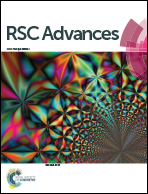Supramolecular assemblies of organotin(iv)–diphosphoryl adducts: insights from X-rays and DFT†
Abstract
Mono-, di- and tri-phenyltin(IV) adducts containing a neutral diphosphoryl ligand, Ph2P(O)OC6H4OP(O)Ph2, were synthesized and characterized. These 2 : 1 adducts of two trans-organotin(IV) moieties and the bridging ligand all crystallize around a centre of inversion. The influence of tin-substituents on the building up of multidimensional architectures, as well as, strength of the Sn–O interactions are discussed in terms of geometrical parameters, Hirshfeld surface analysis and theoretical calculations. The CH⋯Cl interactions make a substantial contribution to directing 1D self-assembly of the tin adducts. Replacement of Cl atoms with Ph groups on tin(IV) in these complexes has increased the probability of CH⋯π and H⋯H interactions and weakens the Sn–O bonds. QTAIM and NBO analyses reveal that the Sn–O interactions are principally electrostatic in nature (donor–acceptor like) with only a small amount of covalence increasing from the tri- to the mono-phenyltin adduct.


 Please wait while we load your content...
Please wait while we load your content...